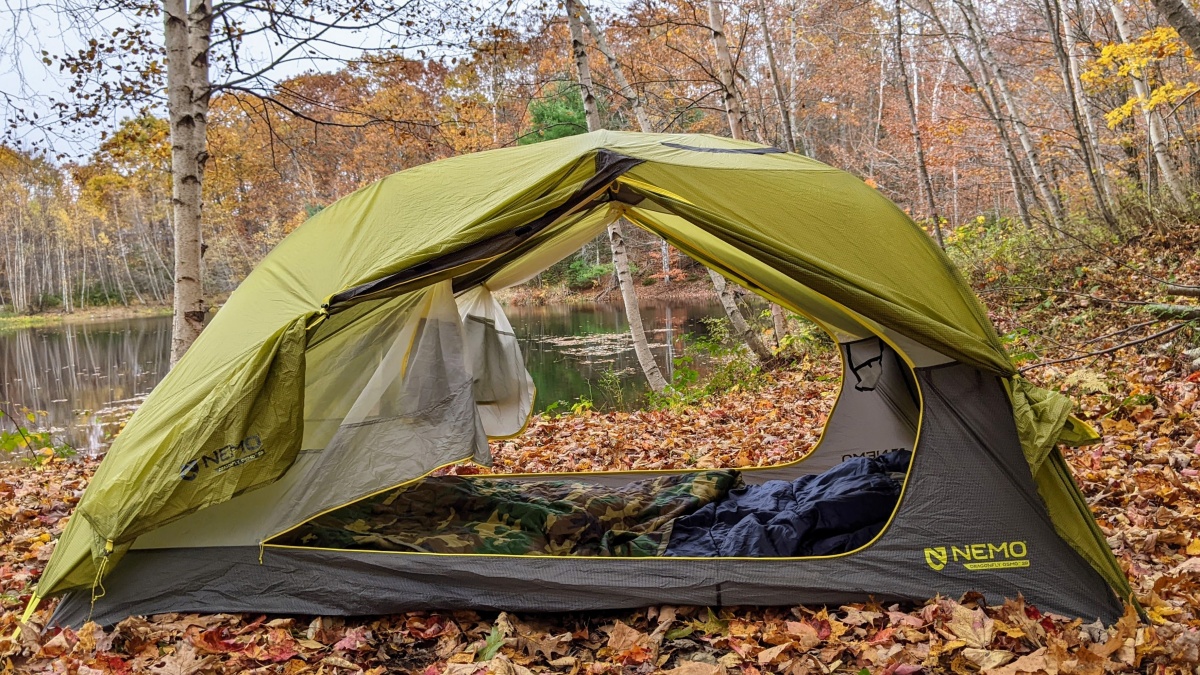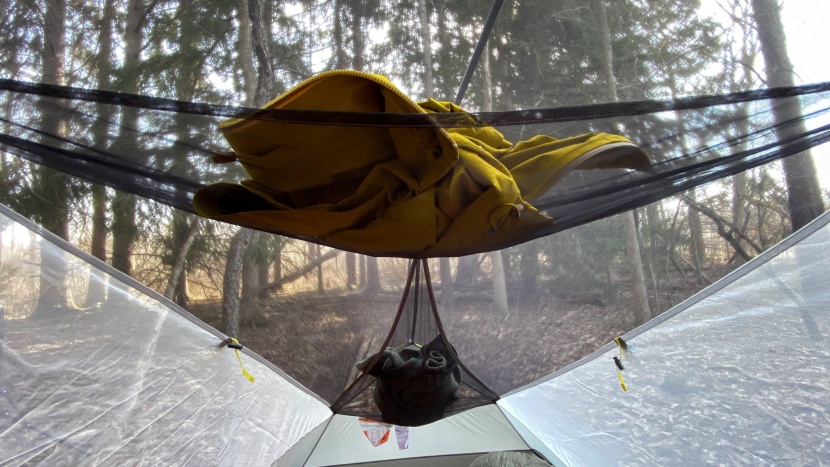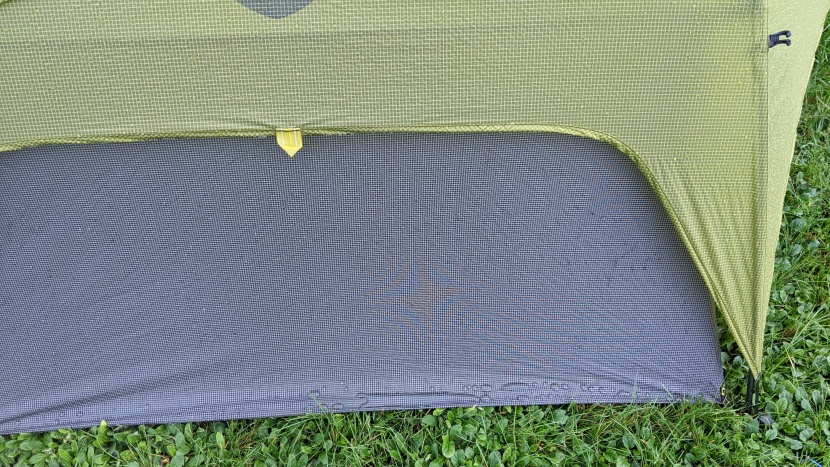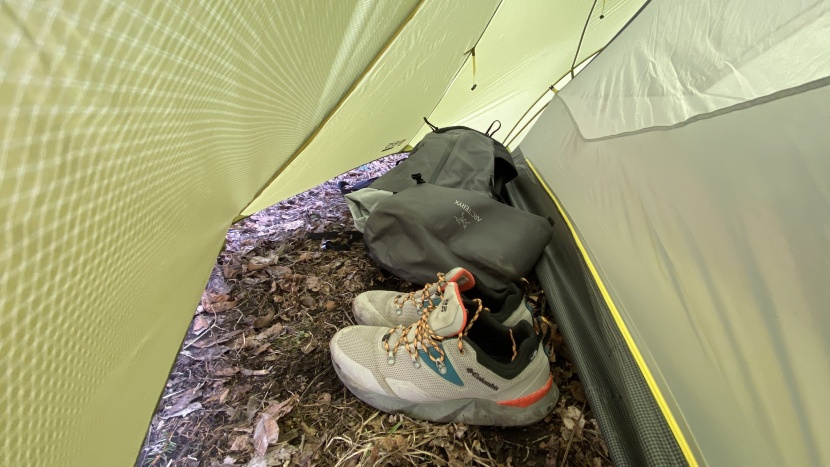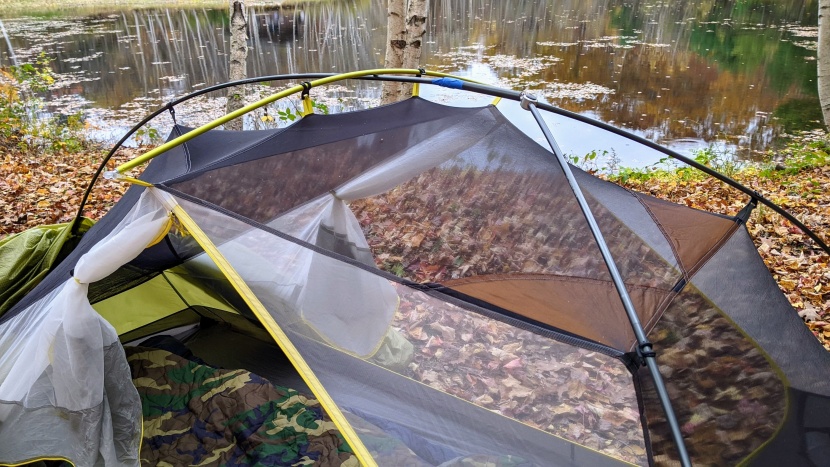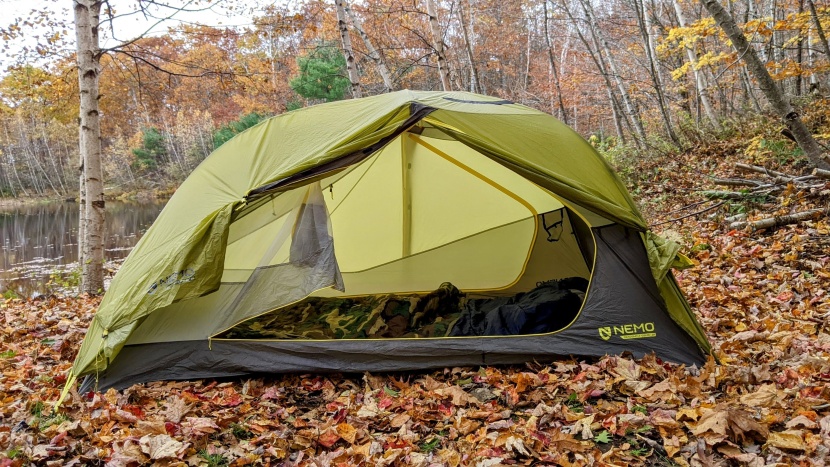
Our Verdict
Our Analysis and Test Results
With 25.6 square feet of floor area and a reasonable peak height of 41 inches, this tent has the dimensions to keep two people comfortable while remaining just 3.4 pounds.
Comfort
The Dragonfly Osmo 2 isn't the roomiest tent, but it provides plenty of comfort. Its 88-inch length is pretty standard for a lightweight backpacking tent, though it's a little narrow, and the taper from 50 inches at the head to 45 inches at the foot is definitely noticeable. However, the two large side doors make it easy to get a bit of extra room if you need to spread out into the vestibule area.
We also appreciate the two-tone mesh canopy. The black fades into the scenery for minimally obstructed star gazing if the weather cooperates, and the white up the sides provides a little more privacy if you need to do a quick wardrobe change and other people are around. If the weather doesn't cooperate, there are struts that prop the fly zippers open for extra ventilation.
The showstopper of this tent's comfort features is the storage pocket system. There are two massive mesh pockets — one at the foot and one overhead. We loved being able to stash bulky items like rain jackets up there to keep them accessible but out of the way. They also make great “drying racks” if you have some damp socks that need airing out. Each side has a small accessory pocket for a phone, glasses, or gloves, and there are two light pockets for a headlamp to cast overhead light at night.
Weather Resistance
This tent stands out for its exceptional fly geometry. It avoids the common problem of wind flap that we often encounter with traditional triangle vestibules. Instead of just one stake point, each vestibule has two, making it super easy to get the fly taut during set-up and ultimately preventing it from sagging and getting the gear underneath wet. The dimensions of each vestibule are also generous, and because of their shape, they do a better job at actually covering gear instead of leaving half of it sticking out of the bottom and exposed to the elements.
The Dragonfly uses a proprietary Osmo ripstop nylon fabric for the tent and fly. We were initially skeptical, but after testing, we noticed that the fly sagged less than other models with regular ripstop nylon. For anyone who has tried to enter or exit a tent on a rainy day and gotten soaked by a floppy fly, this is a noteworthy improvement in materials technology. The fly doors also have small built-in kickstand vents that are meant to facilitate airflow while keeping the fly mostly closed.
On the flip side, the cut-out in the fly saves weight but exposes part of the wall to more weather. During our rain tent, water pooled in a crease by the floor, but never seemed to work its way inside. The floor did feel damp there on occasion, possibly due to condensation.
Space to Weight Ratio
The Dragonfly Osmo 2 registered on our scales at 3.4 pounds. It's not the lightest model in the fleet and offers a little less floorspace and headroom than the most comfortable options, but considering everything else this tent offers, we would take the extra ounces in a heartbeat for a backcountry trip over a long weekend.
Dividing up the weight, with the fly and tent with one person and the poles and stakes with the other, also makes for an evenly split and very reasonable load. The thoughtful design of the Dragonfly includes a roll-down, compressible stuff sack with a clip closure. This lets you isolate a wet fly from the rest of your pack and helps you pack the tent down tightly if you do hand off the poles. We often choose to ditch the stuff sack completely though. Both the tent and fly are easily stuffable around other gear.
Ease of Use
This is an easy tent to pitch. The elastic-connected pole segments click together quickly. The foot-end segments and corresponding sockets on the tent are color-coded to make it easy to get everything oriented correctly. The same is true of the rainfly. Each of the four rounded pole ends snaps quickly and securely into a corresponding socket. Once the poles are set, you clip the tent on underneath them, stake out the corners of the foot box, and you're done.
The only issue we encountered when breaking down the tent is that the sockets are a little too good. On several occasions, we pulled the ball out of the pole instead of the socket. Fortunately, it snaps right back into place.
Construction Quality
This tent toes the line between delicate and durable. It's made with high-quality materials; they are just also very lightweight. Like many of the tents in the review, it comes with fairly standard 8.7mm diameter DAC Featherlite poles. Two sets of them broke during testing, including the pole set on this tent.
We were pitching the tent in the desert and had to tie it out with rocks since the hard-packed soil wouldn't accept stakes. Before we could weigh it down with our gear, a gust of wind caught it and threw it into a tester. The single pole that stretches to the back of the tent broke just below the hub at the top of the tent and ripped a footlong portion of the fly.
Though the tent comes with an emergency splint to repair this type of break in the field, the folded pole was too wide for it to slide over. This was true for the other set of poles we broke as well. We contacted Nemo for a replacement segment and ordered it for a nominal price. They sent us the wrong segment, however, and the complimentary tape they sent to repair the fly failed in a rainstorm and is currently pealing off the tent. It's worth being very careful with this tent as, in our experience, repairs are not easy.
When the tent is intact, its sturdy fly geometry keeps everything from getting wind-whipped and frayed. We also love the triangle-shaped stakes, which can take quite a beating from a rock if you need to drive them into hard-packed earth. They never bent on us.
Should You Buy the Nemo Dragonfly Osmo 2?
If you are in the market for a high-end, lightweight, and comfortable backpacking tent, this is a great way to go. It is no doubt expensive, so if you don't think you will use it multiple times a year on multi-day trips, then there are more affordable options out there. But if you have a big trip planned and need an all-star to go the distance, this one has the storage pockets and weather resistance to round out its balance of lightweight and comfort.
What Other Backpacking Tents Should You Consider?
If you like what the Dragonfly offers but need just a little more width for you and your hiking partner, the Big Agnes Copper Spur UL2 is a very similar tent and a phenomenal option to consider. If you are willing to spend the money and want even more space, then you can't go wrong with the Sea to Summit Telos TR2 or Nemo Dagger Osmo. And if you want a more affordable backpacking tent option, the REI Co-op Half Dome SL 2+ is a reliable (but very bulky) tent that will have you camping in luxury.
| Awards | |
|---|---|
| Price | $500 List Check Amazon (on sale!) |
Overall Score  |
|
| Star Rating | |
| Bottom Line | This tent is an exceptional balance between weight and comfort features with one of the best shapes around |
| Pros | Massive storage pockets, sturdy vestibule shape, dual-tone privacy mesh |
| Cons | Comparatively narrow, expensive, difficult to get into stuff sack |
| Rating Categories | NEMO Dragonfly Osmo 2 |
| Comfort (25%) | |
| Weather Resistance (25%) | |
| Space to Weight Ratio (25%) | |
| Ease of Use (15%) | |
| Construction Quality (10%) | |
| Specifications | NEMO Dragonfly Osmo 2 |
| Type | Two door freestanding |
| Measured Total Packaged Weight (lbs) | 3.40 |
| Dimensions (length x width x peak height) | 88 x 50/45 x 41 in |
| Measured Floor Area (sq ft) | 25.63 |
| Packed Size (length x diameter) | 18 x (5 x 5) in |
| Peak Height | 41 in |
| Interior Floor Area to Weight Ratio, sq ft per pound | 7.54 |
| Measured Headroom Area, sq ft | 13.16 |
| Interior Headroom Area to Weight Ratio, sq ft per pound | 3.87 |
| Vestibule Area | 10 sq ft |
| Number of Doors | 2 |
| Number of Poles | 1 |
| Pole Diameter | 8.7 mm |
| Pole Material | DAC Featherlite |
| Number of Pockets | 6 |
| Guy Points | 6 |
| Gear Loft | Yes |
| Rain Fly Material | 0D OSMO ripstop |
| Inner Tent Material | 10D nylon ripstop |


